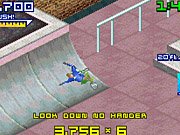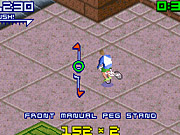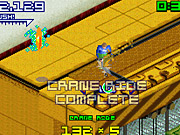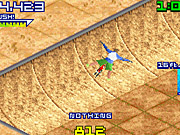Dave Mirra Freestyle BMX 3 isn't much different than Acclaim's previous Mirra game on the Game Boy Advance, but that's not necessarily a complaint, since the sequel builds on what was already an extremely solid product. You can pick between five professional riders, or use the brand-new edit mode to create up to three of your own custom characters, and then improve their skills by completing more than 160 goals scattered throughout nine different environments. Best of all, the game just feels like a BMX video game on a handheld system ought to feel--like a miniaturized version of its console cousin without any compromises or cutbacks.

The main factor behind this achievement is the fact that the developers didn't try to reinvent the genre. Acclaim's Dave Mirra Freestyle BMX 3 looks and plays like Activision's Tony Hawk's Pro Skater series, only you're performing tricks with a bike instead of a skateboard. Graphically, these two games both use 2D backgrounds, an isometric viewpoint, and polygonal riders to convey the sense of realistic, three-dimensional environments. The point here isn't to bury you in comparisons between the Tony Hawk series and the Dave Mirra series, but rather to emphasize the fact that Dave Mirra Freestyle BMX 3 holds its own with what many consider to be the standard-bearer for GBA action sports games. The riders move smoothly and the tricks are beautiful to watch, so if that's the sort of thing you find entertaining, you won't be disappointed.

Dave Mirra Freestyle BMX 3 includes everything you've come to expect from this type of game. This new iteration adds flatland tricks and grind modifications to a repertoire that already included standard grinds, flip tricks, grab tricks, wall taps, wall rides, manuals, and the ability to blend them all together into a seamless aerial ballet. As is common in extreme sports games, each of the environments resembles a real-life location that's been not so subtly laced with ramps, rails, bowls, and pipes. Each area has a set of tasks assigned to it that you're supposed to complete, such as snagging spray cans, grabbing the letters to spell "Mirra," or reaching some out-of-the-way spot. For the most part, the only way to achieve these goals is to kick, grind, and wall-tap your way to them through trial and error.
It's also super easy to perform tricks, which is pretty much why people enjoy action sports games in the first place. Near rails and lips, you can push the B button to stall or grind. If you kick up some air, you can hold the R button and perform flips or spins. With a bit more altitude, you can execute bar and frame tricks. As you practice and get your timing down, it's not uncommon to chain together five or six tricks in midair and link them together with a manual in order to do it all again, with the end result being one hell of a score multiplier. The only real drawback to the whole affair is that Full-Fat, the game's developer, opted to retain the two-minute time limit for runs in the proquest mode. This doesn't give you much time to accomplish more than one or two goals per run, and it's rather sadistic considering the skill required to snag some of the items in later areas.
Thankfully, though, you're not pigeonholed onto a tiny course or forced into set routes. There are multiple ways to reach most items. If you can't execute a continual series of grind transfers, you may be able to accomplish your tasks with big air off a ramp or with a strategically placed wall ride. Likewise, if you'd rather pass the time linking tricks together and goofing off, you can do that too. Each area is large enough that there are many sections to hang out in. The Downtown stage, for example, has a park full of quarter-pipes, a street lined with bus stops and police cars, and rails that lead onto the upper portions of buildings. There's even a subway station you can descend into once you unlock the hardcore challenges.

One significant difference between this and the previous game is the way rewards are earned. In order to increase your rider's skill points or use a new bike, you have to earn cash by accomplishing the goals within each level. Dave Mirra Freestyle BMX 3 doesn't hand out stat boosts as readily as its predecessor, so you actually have to think about what skills you wish to enhance from the beginning in order to properly guide your development. Another new feature involves the inclusion of a trick book for each rider. As you perform the techniques listed in your trick book, you'll gain experience that will make subsequent executions of those stunts faster and flashier. It may not sound like much, but the increases to spin and hang time can lead to higher scores and improve your chances of snagging items in hard-to-reach spots.
The additions of flatland tricks, grind tricks, new levels, and the enhanced stat system don't really represent significant departures from the last game, but they're all tweaks that generally improve the formula. Even the new create-a-rider feature isn't much more than an excuse to play with different clothing styles, but it does give you some control over your character's build and fashion. Other options include session and freeride modes that let you challenge your own high scores, as well as three multiplayer games in which you and a friend can compete to see who can get the highest score, perform the sickest trick, or perform the most tricks in a single combo.

It also bears mentioning that Dave Mirra Freestyle BMX 3 is only the second extreme sports game on the GBA to include a real licensed soundtrack. The first was Acclaim's Aggressive Inline, which was also developed by Full-Fat and released this past summer. The soundtrack includes 10 songs by Saliva, Green Day, Ten Foot Pole, and others. While each song is merely a 40 second clip from the original track, Full-Fat has done a good job of tying together the loops such that you don't really notice when a song restarts. More importantly, the quality is on par with what you'd hear on an FM radio station. The sound effects for stunts and spills aren't nearly as impressive, but they're crisp and more than adequate to get across the action you're seeing onscreen.
Taken as a whole, Dave Mirra Freestyle BMX 3 is a worthy successor to Dave Mirra Freestyle BMX 2, even if it doesn't do much to improve the overall formula. Owners of the last game will enjoy the enhancements to the current iteration, while newcomers will have that much more to explore. Once again, people who enjoy action sports have a legitimate alternative to Tony Hawk.